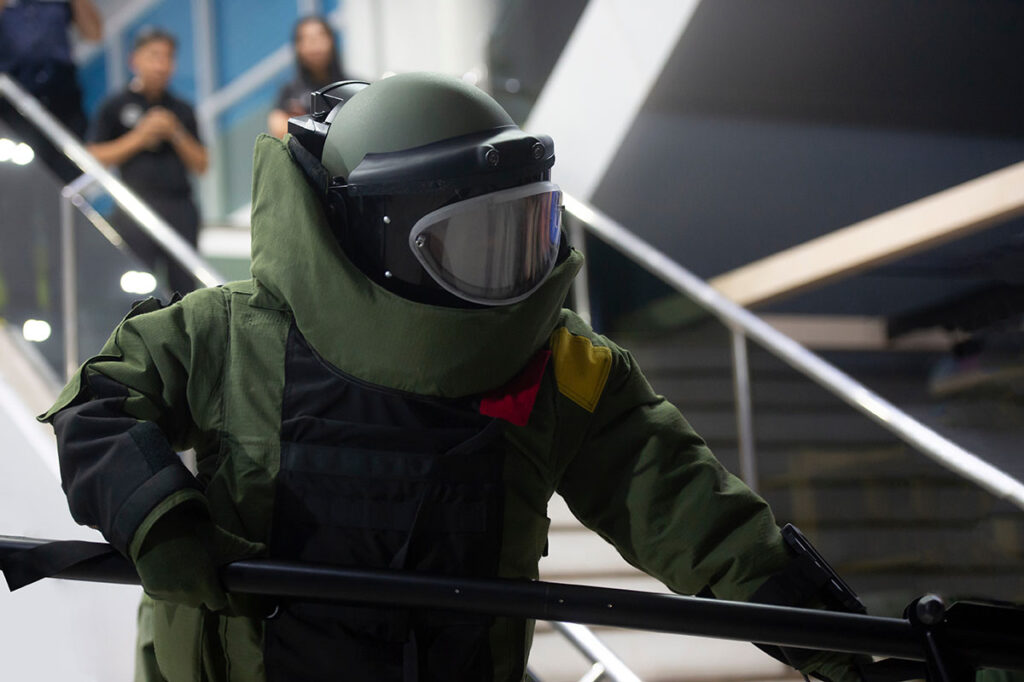The deaths of three experienced Los Angeles County sheriff’s deputies in a devastating explosion at the Biscailuz Center Training Academy on July 18 have sent shockwaves through the emergency management and homeland security community. The incident—currently being investigated as a potential negligent homicide—marks the worst single-day loss for the department since its founding in 1850 and highlights the ever-present dangers faced by bomb technicians and CBRNE (chemical, biological, radiological, nuclear, and explosives) professionals.
At approximately 7:30 a.m. Pacific time, Dets. Joshua Kelley-Eklund, Victor Lemus, and William Osborn were killed while handling explosive materials in the facility’s parking lot. All three were members of the elite Arson Explosives Detail, a highly trained unit within the Sheriff’s Special Enforcement Bureau tasked with neutralizing a wide range of explosive threats—from improvised devices to military ordnance. According to Sheriff Robert Luna, the deputies had just returned from assisting Santa Monica Police with an incident involving grenades discovered in an apartment building storage unit. A subsequent search of the residence is part of an ongoing criminal investigation.
A Dangerous Profession, Even Under Controlled Conditions
The precise cause of the blast is still unknown. However, law enforcement officials suggest it may have stemmed from the instability of materials recovered from the Santa Monica scene. Sheriff Luna emphasized that these deputies were “the best of the best,” with a combined 74 years of experience. Yet even among experts, the line between safety and catastrophe remains razor-thin. Members of the arson explosives team respond to over 1,100 calls per year—many involving decades-old military munitions, commercial blasting agents, or suspicious improvised devices.
“This is a job that requires at least a year of formal training and several more of field experience before technicians feel fully proficient,” noted Ed Nordskog, a 34-year department veteran and former member of the bomb squad. Even so, unpredictable factors—like degraded explosive compounds or improperly stored ordnance—can create fatal outcomes.
Implications for Public Safety and National Security
The tragedy serves as a stark reminder of the critical importance of sustained investment in CBRNE preparedness. The risks extend far beyond individual training centers or crime scenes. Inadequate disposal of explosive materials, gaps in ordnance tracking, and lapses in interagency coordination can quickly escalate into broader threats. For the general public, these incidents underscore the invisible infrastructure working daily to protect lives—from bomb squads and hazmat units to forensic labs and emergency medical personnel.
Preparedness for explosive incidents is not just a matter of professional duty—it is a public health and national security imperative. Whether it’s mitigating the risk of domestic terrorism, ensuring the safe disposal of legacy munitions, or responding to chemical plant disasters, well-trained, well-equipped response teams are vital. The death of these three deputies is a sobering loss not only for their families and colleagues but for the larger system that relies on their expertise.
Investigations Underway
Multiple agencies are now involved in investigating the explosion, including the FBI, the Bureau of Alcohol, Tobacco, Firearms and Explosives (ATF), and the Los Angeles Police Department’s bomb squad. Officials have declared the site an “active crime scene,” and Santa Monica police have evacuated the Bay Street apartment complex in connection with the investigation. Early reports indicate the device may have been negligently manufactured or stored, and criminal charges could be forthcoming depending on the findings.
Authorities emphasized that there is currently no ongoing threat to the public. Nonetheless, the scope of the investigation and the potential criminal implications suggest systemic issues may have contributed to the incident.
Honoring the Fallen
The fallen deputies leave behind not just storied careers but grieving families, friends, and colleagues. Osborn, a department veteran since 1992, was known as a go-to technician for solving novel challenges. Kelley-Eklund, who joined in 2006, had served as a field training officer and murder investigator before joining the explosives detail. Lemus, on the force since 2003, came from a family deeply connected to the Sheriff’s Department and was admired for his training expertise and dedication.
Their deaths prompted an emotional tribute Friday evening, as a law enforcement procession transported their remains past mourners, flags at half-staff, and fellow officers standing in solemn salute.
While law enforcement agencies across the country mourn the loss of these brave professionals, the broader CBRNE and homeland security community must now reckon with hard questions about training protocols, materials handling, and interagency response frameworks. As the investigation continues, stakeholders at every level—from policymakers and scientists to bomb techs and emergency planners—must renew their commitment to ensuring such tragedies remain exceedingly rare.
Sources and Further Reading:


